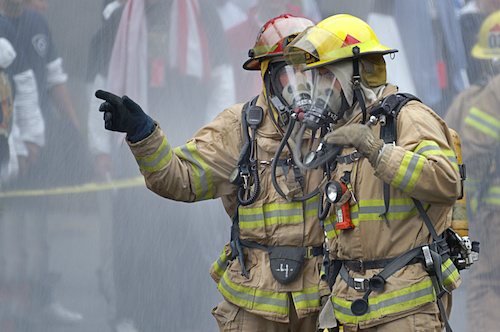
One solution leading the way for the next generation of wireless implementation is Microlab’s SMART (System Monitor Alarm Report Technology) Passives System, comprised of a SMART Gateway and a network of SMART Couplers, which enables real-time performance monitoring of public safety distributed antenna system (DAS) structured cabling, RF components, and antennas deep into a building. With the SMART Passives System, Microlab customers can benefit from faster troubleshooting and reduced time to DAS restoration in the event of a DAS failure. Real-time monitoring with the SMART Passives System is your DAS watchdog.
According to Tom McCabe, Manager of Business Development at Wireless Telecom Group, the SMART Passives System is an innovative, hybrid solution. “The SMART Passives System is a hybrid passive and active diagnostic solution that’s Internet of Things (IoT) based,” said McCabe. “This is an innovative, leading-edge solution developed by Microlab enabling real-time DAS Voltage Standing Wave Ratio (VSWR) monitoring.”
McCabe has over 20 years’ experience with research and development, DAS, and RF design within commercial wireless and public safety. He holds an MS degree from NYU-Polytechnic University and a BS from the New York Institute of Technology. McCabe also has an FCC radiotelephone license and is certified FDNY-ARCS.
McCabe says of public safety solutions, “Unfortunately, we live in a world that’s not ‘standard.’ Meaning, the needs of every public safety site is not a one-size-fits-all approach. That’s where Microlab’s broadband SMART Passives System comes in, for VHF, UHF, and upper UHF in analog and digital systems.”
Why is the SMART Passives System crucial for public safety, and how does it work?
Microlab’s interactive SMART Passives System is comprised of a SMART Gateway that sits at the head end of the DAS. Regarding public safety, it can be a bi-directional amplifier or a dedicated radio repeater. The SMART Couplers — available in 6, 10, 15, and 20 dB — are a direct replacement for the required tappers and couplers used in a passive DAS design. The SMART Gateway communicates to the network of SMART Couplers within a building, qualifying the VSWR at the through and coupled ports. The SMART Passives System monitors the forward and reflected RF power, ensuring all components are working properly, in real-time.
How is Microlab’s SMART Passives System unique?
To sum it up, it’s real-time diagnostics of a mission-critical DAS that’s sniffing out catastrophic failures, such as open or short circuits. To catch these faults, the SMART Passives System monitors both the cabling and antennas critical to DAS performance and RF coverage by verifying and comparing a reference VSWR at each SMART Coupler’s port over time, which is time-stamped and date-stamped by the SMART Gateway. All diagnostics and communications between the SMART Gateway and SMART Couplers occur over the coaxial cabling. Local network connectivity and DC power connections are not required.
“Our design includes high-quality passive and active modules, enclosures, and connectors that enable environmentally sound DAS operation across 100 MHz to 960 MHz,” added McCabe.
Where can the SMART Passives System work?
The SMART Passives System supports various public safety DAS projects. For example, Microlab has worked on large-scale public venue projects such as stadiums, arenas, air and rail transportation hubs, and mixed-use residential buildings, with integration capabilities for projects of all sizes.
According to McCabe, authorities having jurisdiction (AHJ) strictly enforce building owners to implement mission-critical infrastructure for sound public safety radio coverage. In new and old buildings, the SMART Passives System ensures DAS integrity and reliable radio coverage. The SMART Passives System may even be applied to existing, strategic, and historic structures, such as train stations and airports.
“We’ve seen a tremendous uptick in public safety/mission-critical distributed antenna systems. There’s a growing need for high-quality, in-building emergency services for first responders to have flawless radio communications,” said McCabe.
McCabe added, “Our team is committed to connecting and communicating with our customers to aid in proper deployment by offering educational opportunities, such as webinars, application notes, and bill of materials (BOM) review. Regardless of the scale or complexity of the project, Microlab will ensure each client’s project is set up for success.”
What can trip up a public safety DAS project?
“Lack of planning, preparation, and communication with the AHJ and building owner,” answered McCabe.
For a public safety project to be implemented seamlessly (or as near to perfect as possible), having the correct specifications from the AHJ is critical. Some questions to ask, according to McCabe, to ensure you understand the needs and specs of the public safety system include:
- What are the frequencies: VHF, UHF, or upper UHF?
- What are the services: fire, police, EMS, county services, state agencies, or federal agencies?
- Are the evolving 4G/LTE and 5G public safety offerings required?
“It’s critical to obtain the building drawings, so you know the appropriate pathways for the vertical riser/backbone cable for the DAS, as well as your coverage cables. It’s also best to conduct CW test transmissions and measurements to assess the building’s path loss, which enables the calibration of industry-standard software prediction tools, such as iBwave or Ranplan,” said McCabe. “Microlab products are within the iBwave and Ranplan libraries to efficiently model intended coverage.”
According to McCabe, careful and meticulous planning will set a team up for a strong initial deployment and save money by avoiding the need to redesign or enhance. “You can also future proof the design as you’ll likely need to add other public safety features at some point; for example, technology or band agnostic.”
How is Microlab supporting the future of mission-critical communications systems?
“Microlab is supporting traditional land mobile radio (LMR), and the evolving public safety over LTE networks, including AT&T’s FirstNet and offerings from T-Mobile and Verizon Wireless,” said McCabe.
According to McCabe, historic systems like LMR, push-to-talk, and two-way radios, along with the towers that support them, are not going away. These legacy LMR systems will converge with LTE, like AT&T’s FirstNet, enabling first responders to do their jobs more effectively.
Committed to continuous innovation, Microlab helps jurisdictions, building owners, and system integrators develop custom public safety DAS solutions. For example, Microlab can develop a custom combining solution for multiple jurisdictions and radio services that require coverage over a DAS within a building.
“The SMART Passives System is broadband and future proof, covering VHF 100 MHz to upper UHF 960 MHz, and we’ll pass analog FM, digital P25, and TETRA,” said McCabe. “With our innovative solution that ensures reliable DAS network performance and radio coverage, Microlab is here to meet the current and emerging needs of mission-critical communications systems.”
At Microlab, headquartered in Parsippany, NJ, the commitment to performance, quality, and exceptional reliability with timely delivery are key ingredients in establishing and maintaining successful customer relationships. In addition to the SMART Passives System, Microlab supports various signal distribution and deployment applications with a wide variety of high-performance passive components, such as power combiners, directional couplers, attenuators, loads, and filters. For more information or to contact a representative, visit https://microlabtech.com/lmr-public-safety.





Reader Interactions